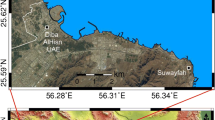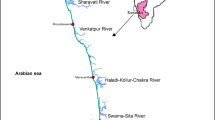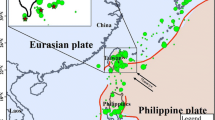Abstract
The Sultanate of Oman is among the Indian Ocean countries that were subjected to at least two confirmed tsunamis during the twentieth and twenty-first centuries: the 1945 tsunami due to an earthquake in the Makran subduction zone in the Sea of Oman (near-regional field tsunami) and the Indian Ocean tsunami in 2004, caused by an earthquake from the Andaman Sumatra subduction zone (far - field tsunami). In this paper, we present a probabilistic tsunami hazard assessment for the entire coast of Oman from tectonic sources generated along the Makran subduction zone. The tsunami hazard is assessed taking into account the contribution of small- and large-event magnitudes. Results of the earthquake recurrence rate studies and the tsunami numerical modeling for different magnitudes were used through a logic-tree to estimate the tsunami hazard probabilities. We derive probability hazard exceedance maps for the Omani coast considering the exposure times of 100, 250, 500, and 1000 years. The hazard maps consist of computing the likelihood that tsunami waves exceed a specific amplitude. We find that the probability that a maximum wave amplitude exceeds 1 m somewhere along the coast of Oman reaches, respectively, 0.7 and 0.85 for 100 and 250 exposure times, and it is up to 1 for 500 and 1000 years of exposure times. These probability values decrease significantly toward the southern coast of Oman where the tsunami impact, from the earthquakes generated at Makran subduction zone, is low.








Similar content being viewed by others
References
Aki K (1972) Earthquake mechanism. Tectonophysies 13:423–446
Aldama-Bustos G, Bommer JJ, Fenton CH, Stafford PJ (2009) Probabilistic seismic hazard analysis for rock sites in the cities of Abu Dhbi, Dubai and Ra's Al Khymah, United Arab Emirates. Georisk 3-1:1–29. doi:10.1080/17499510802331363
Allen SCR, Greenslade DJM (2010) Model-based tsunami warnings derived from observed impacts. Nat Hazards Earth Syst Sci 10:2631–2642
Ambraseys NN, Melville CP (1982) A history of Persian earthquakes. Cambridge Univ. Press, Cambridge
Anderson JG, Luco JE (1983) Consequences of slip rate constraints on earthquake occurrence relations. Bull Seismol Soc Am 73(2):471–496
Annaka T, Satake K, Sakakiyama T, Yanagisawa K, Shuto N (2007) Logic-tree approach for probabilistic tsunami hazard analysis and its applications to the Japanese coasts. Pure Appl Geophys 164:577–592
Aubin J (1973) Le Royaume d’Ormuz au de’but du XVIe Sie’cle. Mare Luso-Indicum 4:77–179
Beghoul N, Chatelian J, Boughach M, Benhallou H, Dadou R, Slach A (2010) Seismic empirical relations for the Tellian atlas, North Africa, and their usefulness for seismic risk assessment. Pure Appl Geophys 167:277–321
Berberian M, King GCP (1981) Towards a paleogeography and tectonic evolution of Iran. Can J Earth Sci 18-2:210–265. doi:10.1139/e81-019
Brune JN (1968) Seismic moment, seismicity and rate of slip along major faults zones. Journal Geophysical Research 73:777–784
Burbidge D, Cummins PR, Mleczko R, Thio HK (2008) A probabilistic tsunami hazard assessment for Western Australia. Pure Appl Geophys 165(11–12):2059–2088
Burbidge DR, Cummins PR, Mleczko R, Latief H, Mokhtari M (2009). A probabilistic tsunami hazard assessment of the Indian Ocean nations. s.l. : Geoscience Australia Professional Opinion No. 2009/11. https://d28rz98at9flks.cloudfront.net/68717/68717.pdf. Assessed 2 May 2016
Bus Z, Gerenerczy G, Toth L, Monus P (2009) Active crustal deformation in two seismogenic zones of the Pannonian region—GPS versus seismological observations. Tectonophysics 474:343–352. doi:10.1016/j. tecto. 2009.02.045
Byrne DE, Sykes LR, Davis SM (1992) Great thrust earthquakes and aseismic slip along the plate boundary of the Makran subduction zone. J Geophys Res 97(B1):449–478. doi:10.1029/91JB02165
Coppersmith KJ, Youngs RR (1986). Capturing uncertainty in probabilistic seismic hazard assessments within intraplate tectonic environments, Proceedings of the Third U.S. National Conference on Earthquake Engineering, Charleston, South Carolina, pp. 301–312
Deif A, El-Hussain I (2012) Seismic moment rate and earthquake mean recurrence interval in the major tectonic boundaries around Oman. J Geophys Eng 9:773–783. doi:10.1088/1742-2132/9/6/773
DeMets D, Gordon RG, Argus DF (2010) Geologically current plate motions. Geophys J Int 181:1–80. doi:10.1111/j.1365-246X.2010.04491.x
Edwards RA, Minshull TA, White RS (2000) Extension across the Indian-Arabian plate boundary: the Murray ridge. Geophys J Int 142(2):461–477. doi:10.1046/j.1365-246x.2000.00163.x
Fournier M, Chamot-Rooke N, Rodriguez M, Huchon P, Petit C, Beslier M-O, Zaragosi S (2011) Owen fracture zone: the Arabia-India plate boundary unveiled. Earth Planet Sci Lett 302:247–252. doi:10.1016/j.epsl.2010.12.027
GEBCO (2014). The general bathymetric chart of the oceans, GEBCO_2014 Grid, version 20150318, available at: http://www.gebco.net, last access: September
Geist EL, Lynett PJ (2014) Source processes for the probabilistic assessment of tsunami hazards. Oceanography 27(2):86–93
Geist EL, Parsons T (2006) Probabilistic analysis of tsunami hazards. Nat Hazards 37(3):277–314. doi:10.1007/s11069-005-4646-z
González FI, Geist EL, Jaffe B, Kânoğlu U, Mofjeld H, Synolakis CE, Titov VV, Arcas D, Bellomo D, Carlton D, Horning T (2009) Probabilistic tsunami hazard assessment at seaside, Oregon, for near- and far-field seismic sources. J Geophys Research (Oceans) 114(C11):1978–2012
Gutenberg B, Richter CF (1954) Seismicity of the earth and associated phenomena. S.L. Hafner, New York
Hanks TC, Kanamori K (1979) A moment magnitude scale. J Geophys Res 84(B5):2348–2350 . doi:10.1029/JB084iB05p023489B0059
Harms JC, Cappel HN, Francis DC (1984) The Makran coast of Pakistan: its stratigraphy and hydrocarbon potential. Marine geology and oceanography of Arabian Sea and coastal Pakistan. Van Nostrand Reinhold, New York, pp. 3–26
Heidarzadeh M, Kijko A (2011) A probabilistic tsunami hazard assessment for the Makran subduction zone at the northwestern Indian Ocean. Nat Hazards 56(3):577–593. doi:10.1007/s11069-010-9574-x
Heidarzadeh M, Satake K (2014) Possible sources of the tsunami observed in the northwestern Indian Ocean following the 2013 September 24 Mw 7.7 Pakistan inland earthquake. Geophys J Int 199(2):752–766
Heidarzadeh M, Pirooz MD, Zaker NH, Yalciner AC, Mokhtari M, Esmaeily A (2007) Historical tsunami in the Makran subduction zone off the southern coasts of Iran and Pakistan and results of numerical modeling. Ocean Eng 30-35(8):774–786. doi:10.1016/j.oceaneng.2008.01.017
Heidarzadeh M, Pirooz MD, Zaker NH, Synolakis CE (2008) Evaluating tsunami hazard in the northwestern Indian Ocean. Pure Appl Geophys 165(11–12):2045–2058
Hoechner A, Babeyko AY, Zamora N (2016) Probabilistic tsunami hazard assessment for the Makran region with focus on maximum magnitude assumption. Nat Hazards Earth Syst Sci 16:1339–1350. doi:10.5194/nhess-16-1339-2016
Huhn K, Kukowski N, Schillhorn T, Flueh E (1998) Morphotectonics of the Makran accretionary wedge imply new aspects for the plate tectonic situation in the northeast Indian Ocean. http://www.geomar.de/add_info/former_info/abstracts98/agu98abstracts.html Accessed 23-25 May 2006
Jacob KH, Quittmeyer RL (1979) The Makran region of Pakistan and Iran: trench-arc system with active plate subduction. Geodynamics of Pakistan: 305–317. eds Farah, A. de Jong, K.A., Geological Survey of Pakistan, Quetta
Kanamori H, Anderson DL (1975) Theoretical basis of some empirical relations in seismology. Bull Seismol Soc Am 65(5):1073–1095
Kopp C, Fruehn J, Flueh ER, Reichert C, Kukowski N, Bialas J, Klaeschen D (2000) Structure of the Makran subduction zone from wide angle and reflection seismic data. Tectonophysics 329:171–191. doi:10.1016/S0040-1951(00)00195-5
Krishna R, Sanu T (2002) Shallow seismicity, stress distribution and crustal deformation patterns in the Andaman-west Sunda arc and Andaman Sea, northeastern Indian Ocean. J Seismol 6:25–41
Kukowski N, Schillhorn T, Flueh ER, Huhn K (2000) Newly identified strike-slip plate boundary in the northeastern Arabian Sea. Geology 28(4):355–358. doi:10.1130/0091-7613
Liu PLF, Woo SB, Cho YS (1998). Computer programs for tsunami propagation and inundation. Technical report, Cornell University
Lorito S, Tiberti MM, Basili R, Piatanesi A, Valensise G (2008) Earthquake-generated tsunamis in the Mediterranean Sea: scenarios of potential threats to southern Italy. J Geophys Res Solid Earth 113(B1):1978–2012
Lorito S, Selva J, Basili R, Romano F, Tiberti MM, Piatanesi A (2015) Probabilistic hazard for seismically induced tsunamis: accuracy and feasibility of inundation maps. Geophys J Int 200(1):574–588
Masson F, Anvari M, Djamour Y, Walpersdorf A, Tavakoli F, Daignieres M, Nankali H, Van Gorp S (2007) Large-scale velocity field and strain tensor in Iran inferred from GPS measurements: new insight for the present-day deformation pattern within NE Iran. Geophys J Int 170:436–440. doi:10.1111/j.1365-246X.2007.03477.x
McCall GJH (2002) A summary of the geology of the Iranian Makran. In: Clift PD, Kroon D, Gaedicke C, Craig J (eds) The tectonic and climatic evolution of the Arabian Sea region, vol 195. Geological Society, London Special Publications, pp. 147–204
Minshull TA, White RS, Barton PJ, Collier JS (1992) Deformation at plate boundaries around the Gulf of Oman. Mar Geol 104:265–277
Miranda JM, Luis J, Reis C, Omira R, Baptista MA (2014). Validation of NSWING, a multicore finite difference code for tsunami propagation and run up. American Geophysical Union Fall Meeting, S21 A4390. http://adsabs.harvard.edu/abs/2014AGUFM.S21A4390M
Mokhtari M, Fard IA, Hessami K (2008) Structural elements of the Makran region, Oman Sea and their potential relevance to tsunamigenesis. Nat Hazards 47(2):185–199. doi:10.1007/s11069-007-9208-0
Molnar P (1979) Earthquake recurrence intervals and plate tectonics. Bull Seismol Soc Am 69:115–133
Muscat Intelligence Summary (1945). Public Record Office Document. United Kingdom : India Office Records IOR R/15/6/359. British Library
Musson RMW (2009) Subduction in the western Makran: the historian's contribution. J Geol Soc 166(3):387–391. doi:10.1144/0016-76492008-119
Nagarajan B, Suresh I, Sundar D, Sharma R, Lal AK, Neetu S, Shenoi SS, Shetye SR, Shankar D (2006) The great tsunami of 26 December 2004: a description based on tide-gauge data from the Indian subcontinent and surrounding areas. Earth Planets Space 58(2):211–215. doi:10.1186/BF03353380
Nilgun S (2005) An application of the time and magnitude-predictable model to long-term earthquake prediction in eastern Anatolia. J Seismol 9:367–379
Okada Y (1985) Surface deformation due to shear and tensile faults in a half-space. Bull Seismol Soc Am 75.4(1985):1135–1154
Okal E, Fritz HM, Synolakis CE, Raad PE, Al-Shijbi Y, Al-Saifi M (2006) Field survey of the 2004 Indonesian tsunami in Oman. Earthquake Spectra 22:S203–S218. doi:10.1193/1.2202647
Omira R, Baptista MA, Matias LM (2015) Probabilistic tsunami hazard in the Northeast Atlantic from near and far-field tectonic sources. Pure App Geophys 172(3–4):901–920. doi:10.1007/s00024-014-0949-x
Omira R, Matias LM, Baptista MA (2016a) Developing an event-tree probabilistic tsunami inundation model for NE Atlantic coasts: application to a case study. Pure App. Geophys. doi:10.1007/s00024-016-1367-z
Omira R, Baptista MA, Lisboa F (2016b) Tsunami characteristics along the Peru-Chile trench: analysis of the 2015 Mw8.3 Illapel, the 2014 Mw8.2 Iquique and the 2010 Mw8.8 Maule tsunamis in the near-field. Pure App Geophys 173:1063–1077
Page WD, Alt JN, Cluff LS, Plafker G (1979) Evidence for the recurrence of large-magnitude earthquakes along the Makran coast of Iran and Pakistan. Tectonophysics 52(1):533–547. doi:10.1016/0040-1951(79)90269-5
Pendsee CG (1946) The Mekran earthquake of the 28th November 1945. India Meteorol depart Sci. Notes 10(125):141–145
Power W, Downes G, Stirling M (2007) Estimation of tsunami hazard in New Zealand due to south American earthquakes. Pure Appl Geophys 164:547–564
Qin C, Papadimitriou EE, Papazachos BC, Karakaisis GF (2001) Time-dependent seismicity in China. J Asian Earth Sc 19(1):97–128. doi:10.1016/S1367-9120(00)00019-5
Quittmeyer RC (1979) Seismicity variations in the Makran region of Pakistan and Iran: relation to great earthquake. Pure Appl Geophys 117:1213–1228. doi:10.1007/BF00876216
Quittmeyer RC, Jacob KH (1979) Historical and modem seismicity of Pakistan, Afghanistan, northwestern India, and southeastern Iran. Bull Seismol Soc Am 69:773–823
Rabinovich AB, Thomson RE (2007) The 26 December 2004 Sumatra tsunami: analysis of tide gauge data from the world ocean part 1. Indian Ocean and South Africa. In Tsunami and Its Hazards in the Indian and Pacific Ocean: 261–308. doi:10.1007/s00024-006-0164-5
Rikitake T, Aida I (1988) Tsunami hazard probability in Japan. Bull Seismol Soc Am 78(3):1268–1278
Rodriguez M, Chamot-Rooke N, Hébert H, Fournier M, Huchon P (2013) Owen ridge deep-water submarine landslides: implications for tsunami hazard along the Oman coast. Nat Hazards Earth Syst Sci 13:417–424
Roshan AD, Basu PC, Jangid RS (2016) Tsunami hazard assessment of Indian coast. Nat Hazards 82:733–762. doi:10.1007/s11069-016-2216-1
Sørensen MB, Spada M, Babeyko A, Wiemer S, Grünthal G (2012) Probabilistic tsunami hazard in the Mediterranean Sea. Journal of Geophysical Research (Solid Earth) 117(B1):1978–2012
Swapna M, Srivastava K (2014) Effect of Murray ridge on the tsunami propagation from Makran subduction zone. Geophys J Int 199(3):1430–1441
Tselentis GA, Stavrakakis G, Makropoulos K, Latousakis J, Drakopoulos J (1988) Seismic moments of earthquakes at the western Hellenic arc and their application to the seismic hazard of the area. Tectonophysics 148:73–82
Vernant P, Nilforoushan F, Hatzfeld D, Abassi MR, Vigny C, Masson F, Nankali H, Martinod J, Ashtiani A, Bayer R, Tavakoli F, Chery J (2004) Present-day crustal deformation and plate kinematics in Middle East constrained by GPS measurements in Iran and northern Oman. Geophys J Int 157:381–398. doi:10.1111/j.1365-246X.2004.02222.x
Visini F, Nardis R, Lavecchia A (2010) Rates of active compressional deformation in Central Italy and Sicily, evaluation of the seismic budget. International Journal of Earth Science 99:S243–S264
Wiens DA, DeMets C, Gordon RG, Stein S, Argus D, Engeln JF, Lundgren P, Quible D, Stein C, Weinstein S, Woods DF (1985) A diffuse plate boundary model for Indian Ocean tectonics. Geophys Res Lett 12(7):429–432
Yadav RBS, Shanker D, Chopra S, Singh A (2010) An application of regional time and magnitude predictable model for long-term earthquake prediction in the vicinity of October 8, 2005 Kashmir Himalaya earthquake. Natural Hazard 54:985–1014
Yadav RBS, Tripathi JN, Kumar TS (2013) Probabilistic assessment of tsunami recurrence in the Indian Ocean. Pure Appl Geophys 170(3):373–389. doi:10.1007/s00024-012-0487-3
Acknowledgments
This work was done in the framework of the project on Tsunami Hazard Assessment for the Oman Liquefied Natural Gas. We would like to express our appreciation to the Oman Liquefied Natural Gas (OLNG) for funding this project. Our sincere thanks are due to the OLNG staff: Hamed Al-Naamani, Nasser Al-Makhroumi, Salim Al-Harrassy, and Najim Al-Araimi for their support. We would like also to thank all the staff of the Earthquake Monitoring Center of Sultan Qaboos University for their continuous interest and their assistance in the completion of this work. The authors wish to thank the reviewers of the paper for their comments and corrections that greatly improved the paper.
Author information
Authors and Affiliations
Corresponding author
Rights and permissions
About this article
Cite this article
El-Hussain, I., Omira, R., Deif, A. et al. Probabilistic tsunami hazard assessment along Oman coast from submarine earthquakes in the Makran subduction zone. Arab J Geosci 9, 668 (2016). https://doi.org/10.1007/s12517-016-2687-0
Received:
Accepted:
Published:
DOI: https://doi.org/10.1007/s12517-016-2687-0




